THE UC HIVE SEP 2023
In the Aftermath of Hurricane Kay (part 3) — Mulegé
Much of my time in the field between Nov 2022 and early Jan 2023 was spent on day trips to various corners of my study area around Mulegé to assess the storm damage and see what plants the summer storms had brought us. For a full list of plants (family, Latin name and common names in both English and Spanish), visit this page.
If you’re new to Notes from South of the Border, let me quote my own description of the area: the town of Mulegé is located on the floodplain, banks and hillsides of a wide river valley. ‘Descending from the mountains to the west of the study area are gentle sloping alluvial fans criss-crossed by dry watercourses that originate from larger canyons and gullies in the mountains. The Mulegé valley is a huge alluvial flow that descends gradually to sea level, disgorging into the Mulegé estuary and the Gulf of California. Along the freshwater portion of the river is a palm oasis” (from my Mulegé Flora Project pages).
Hurricane or tropical storm damage can vary greatly and it is common that water and flood damage is not uniform due to factors such as location, topography, elevation and vegetation cover.
Hurricane Kay caused widespread damage along the entire length of the peninsula in mid September 2022. In and near the town of Mulegé, it brought heavy rain. Unfortunately, the hurricane had been preceded by just a few days by an unexpected squall (chubasco) that over 24 hours soaked the hillsides, precipitated a flash flood and left the area waterlogged.
The heavy rains from Kay had nowhere to go but downhill, resulting in the second flood in less than a week. With many smaller arroyos in the mountains feeding into the main arroyo in the valley, runoff builds up quickly and soon becomes a torrent as it moves downhill, reaching peak speed as the streams converge and the arroyo walls narrow closer to central Mulegé. Along the way, the flashflood washes away or buries agricultural crops, fells trees and buildings, carries along river rock, silt, livestock and other debris, and gouges deeply into the loosely packed, fine volcanic alluvium that is the valley floor.
Natural events like the flash flooding caused by Hurricane Kay provide many opportunites for those of us interested in the natural world. Questions like: "How has any given area/habitat changed?" "Which plants withstood the flood and which didn't?" "Which organisms seem to have benefitted from the disturbance?" "Over time, which organisms are still missing from a location?" "How is the composition of plants in any particular disturbed habitat changing?" "What new habitats might have been created?" These are just a few of the questions that have interested me as I have observed and documented plants and the local environment in the aftermath of summer storms over the past 22 years. In this and the upcoming few months, I hope to address some of these questions.
El Crucerito (el Ojo), Mulegé

February 2020 at the wetland near the Ojo.
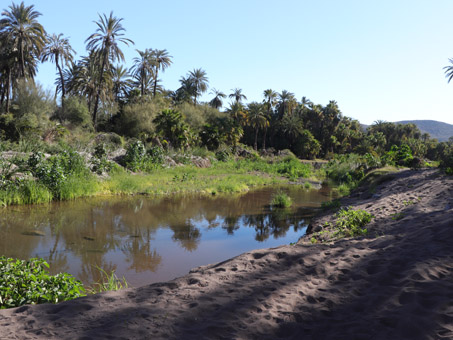
November 2022
As seen in the two images above, the dense, impenetrable vegetation present in 2020 was gone after the 2022 flash flood. The bank had been gouged down about a meter and the water course was now almost completely bare where there had been in early 2020 dense stands of Cattails (Typha domingensis), Castorbean (Ricinus communis), Common Reed (Phragmites australis), and Bulrush (Schoenoplectus americanus) the filled the channel from one side of the bank to the other, and where the water was barely visible though all the vegetation. Next month I'll return to this area for indepth coverage. Meanwhile, check out the "El Ojo de Agua" section on this page of my Mulegé Flora Project for more on the changes to this area over the years.
When I visited the site in mid November, the flattened stalks of the Cattails, Giant Reed and Bulrushes were the only evidence that there had been a healthy freshwater marsh here prior to the Sep 2022 flood. New growth, just two months later is already visible in both the submerged and exposed portions of the river bed.

Cavernous Crystalworts (Riccia cavernosa, Marchantiales) dotted soils along the river and in damp areas of the oasis. Just one of the thousands of Tree Tobacco (Nicotiana glauca) seedlings popping up in disturbed soils all over the place.
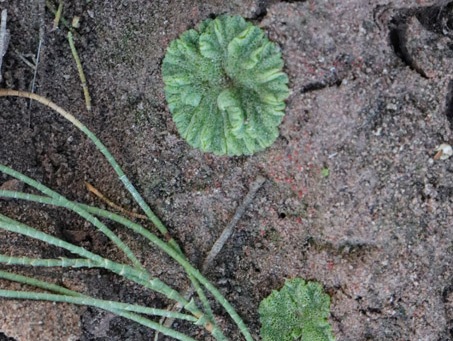
Cavernous Crystalwort (Riccia cavernosa) is a small thalloid liverwort c. 2.5 cm D. The green “twigs” are actually branchlets of Salt Cedar/ Pino Salado (Tamarix aphylla) while the leaves are those tiny scale-like protrusions giving the branchlets a jointed look.
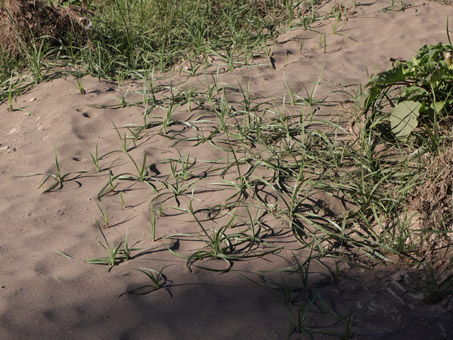
Purple Sedgenut / Coquillo Rojo (Cyperus rotundus). This is a non-native species that can occur, as in the photo, in grasslike patches. It has small, round tubers.
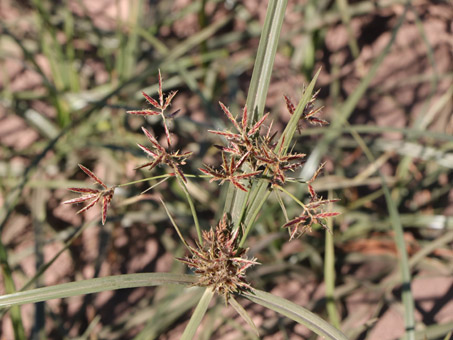
Inflorescences of Purple Sedgenut (Cyperus rotundus). This species has popped up and disappeared throughout the oasis area with successive floods and seems to be doing well again this year.
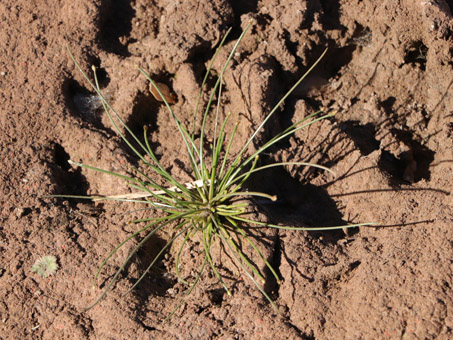
Annual Spikerush / Junquillo (Eleocharis geniculata). This is a very small example, only about 10 cm across, but even at this diminutive size, it already has inflorescences.

A slightly larger Annual Spikerush with a young Blue Streamwort (Stemodia durantifolia var. durantifolia). These species are usually found close to the edge of the river or on the damper areas of the banks, but these, along with many others, were growing in what was now a dry part of the oasis.
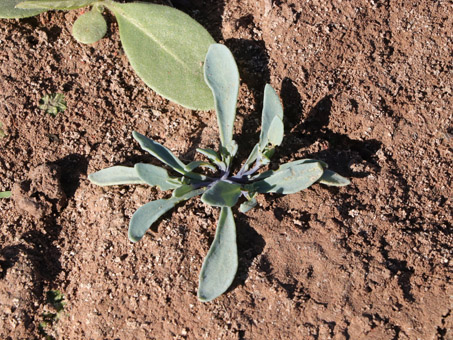
Alkali Heliotrope / Hierba del sapo (Heliotropium curassavicum var. oculatum) and a few leaves (top left) of Tree Tobacco / Levántate Don Juan seedlings (Nicotiana glauca).
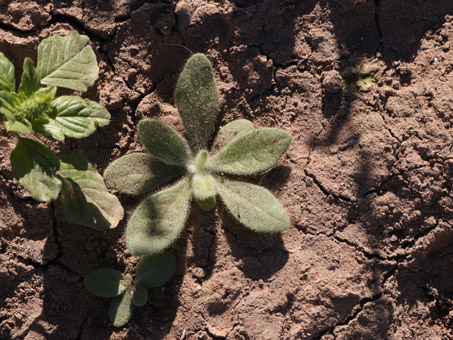
Amaranth / Quelite verde seedling (Amaranthus watsonii) already with an inflorescence and the young, fuzzy leaves of a Desert tobacco / Tabaquillo del Coyote (Nicotiana obtusifolia).
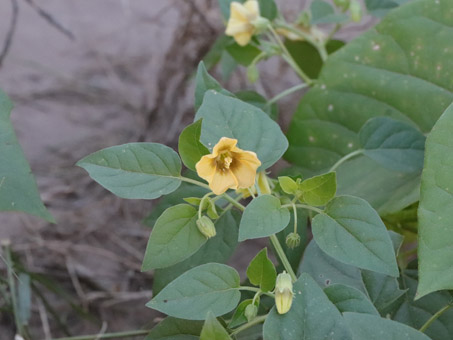
Groundcherry / Tomatillo (Physalis crassifolia var. crassifolia) is a common native annual that occurs in desert scrub and less often in riparian areas. The ovate leaves have entire margins. There are 5 brown spots at the base of the corolla, the stamens are yellow, and the corolla is commonly rotate or reflexed.

In contrast, Hairy Groundcherry / Tomatillo (Physalis pubescens) occurs mostly in riparian areas or in gardens around Mulegé. It has ovate leaves that are usually coarsely toothed. According to Rebman et al. (2016), this is also probably native to the peninsula.
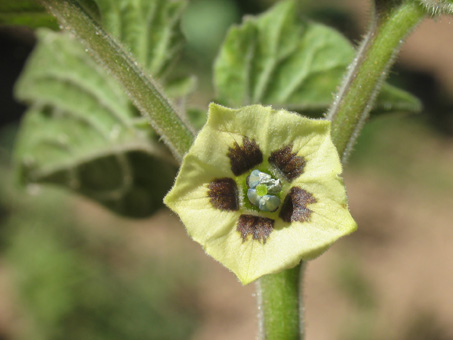
Hairy Groundcherry (Physalis pubescens). The bell-shaped corollas also have brown spots at the base and it does not become reflexed. The stamens are blue.
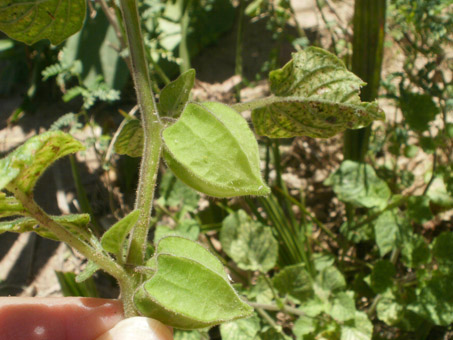
The inflated sepals of both Groundcherry species (P. pubescens seen here) have ten ribs and enclose the small, fleshy berry.
West Ojo Wetland — Mulegé
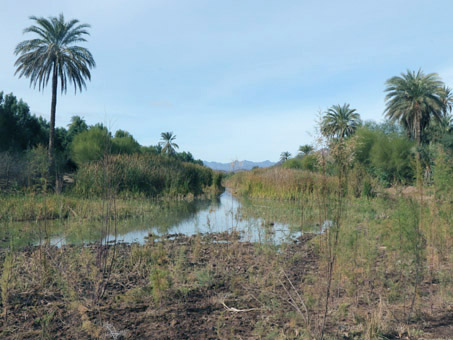
The new wetland area by the icehouse in Jan 2021
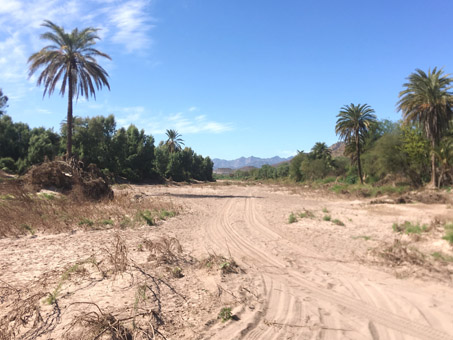
The same wetland area mid November 2022 after Hurricane Kay. This is also what it originally looked like in 2015 after the canal was bulldozed through this section of the palm orchard.

November 2022

November 2022. All that's left of the previous wetland was the stalks of Salt Cedar / Pino Salado (Tamarix ramosissima) and Cattails.
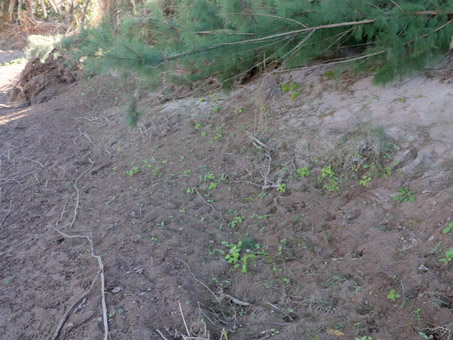
New sprouts were coming up all over the area.
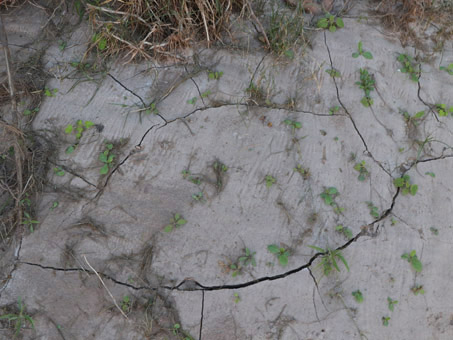
More sprouts.
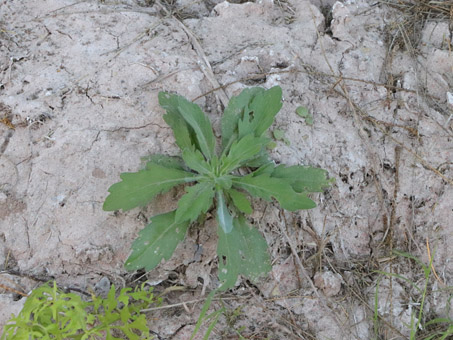
Flax-Leaf Fleabane / Escoba de Arroyo (Erigeron bonariensis), a non-native weedy species found mostly in the oasis areas.
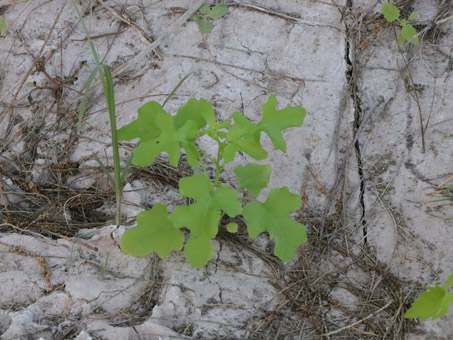
This Palmer Rock-Mustard seedling (Dryopetalon palmeri) was about 20 cm H. This is a near-endemic species with pale lavender flowers. It ranges from c. Mulegé to the Cape mostly on the Gulf Coast.
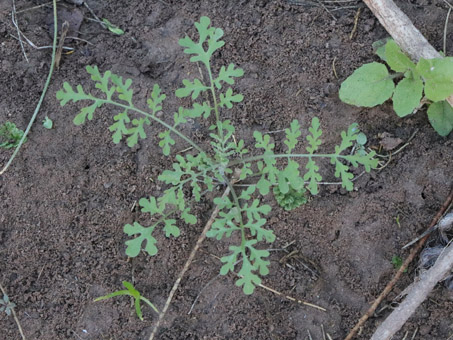
Young Western Tansy-Mustard / Pamita (Descurainia pinnata subsp. brachycarpa). This is uncommon around Mulegé, mostly found in the oasis.

Big Bur-Sage / Chicura del Arroyo (Ambrosia ambrosioides). A native species common in arroyos. The herbage is glandular-pubescent and pleasantly fragrant.
.
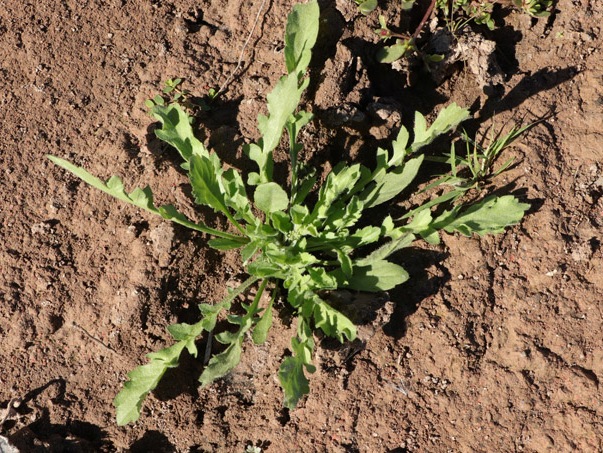
Broad-Leaf Peppergrass / Lentigia Cimarona (Lepidium lasiocarpum var. latifolium). An uncommon native variety that occurs from Cataviña to the Cape.

New flowers and young fruit of Broad-Leaf Peppergrass. It is mostly found in disturbed soils in the oasis area, around town and the valley.

Coast Hofmeisteria (Hofmeisteria fasciculata). While this species is most common on cliffs and slopes near the coast, it can also occasionally be found in desert water courses, esp. where its seeds may have been washed downhill from slopes/cliffs.
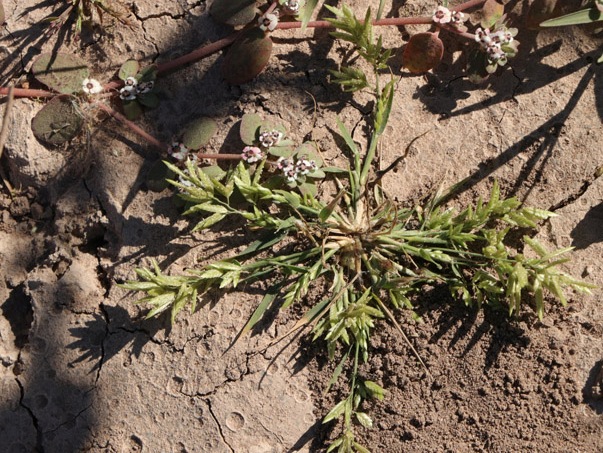
Stinkgrass / Zacate Apestoso (Eragrostis cilianensis var. cilianensis), a worldwide weed and the native Louse spurge / Golondrina (Euphorbia pediculifera var. pediculifera). Both specimens are small, about 12-15 cm D, but covered with flowers.
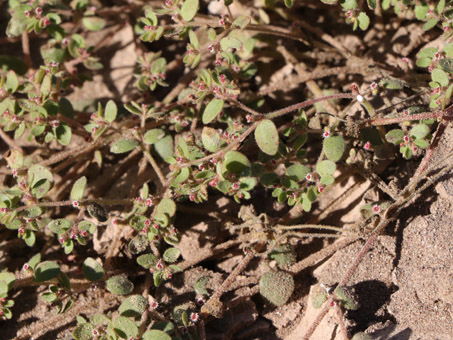
Fringe Spurge / Golondrina (Euphorbia setiloba) occurs throughout most of the peninsula and seems to favor loose, sandy or silty soils.
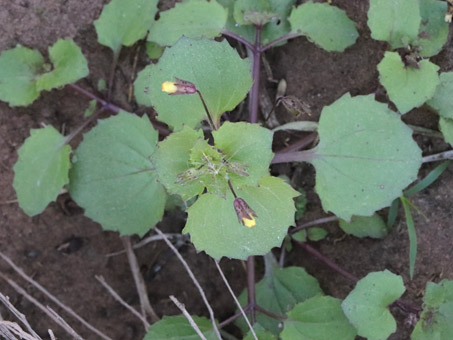
Short-Tooth Monkey Flower (Erythranthe brevinasuta). This rare species is endemic and found from s BC to central BCS . It generally occurs in riparian areas of the mountains to the W of Mulegé, but occasionally can be found in the Mulegé oasis, especially along the river.
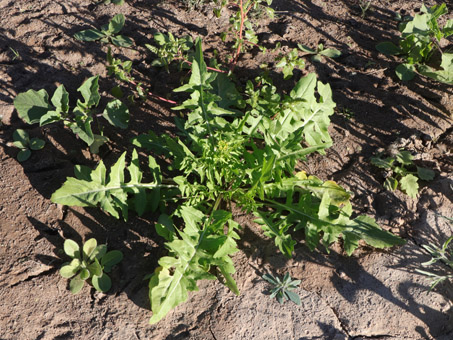
London Rocket / Mostacilla Común (Sisymbrium irio), a fairly common weedy non-native annual in disturbed areas.
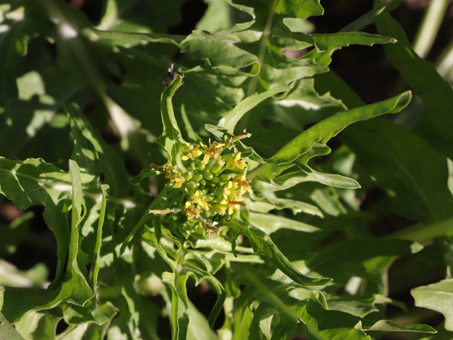
London rocket produces prodigious numbers of fruit and seeds.
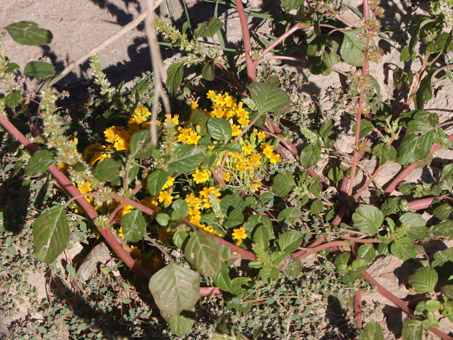
A mixed patch of common summer native annuals: Watson Amaranth (Amaranthus watsonii), Small-seed Sandmat / Golondrina (Euphorbia polycarpa var. polycarpa) and Desert Chinchweed (Pectis papposa var. papposa).
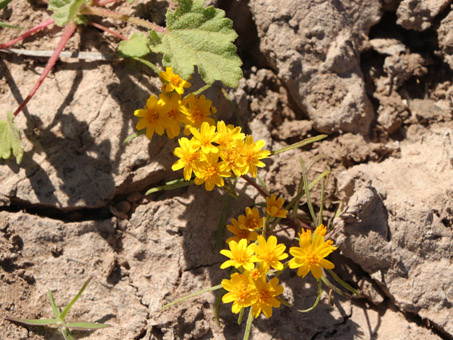
Desert Chinchweed / Manzanilla del Coyote (Pectis papposa var. papposa).
Mulegé Valley
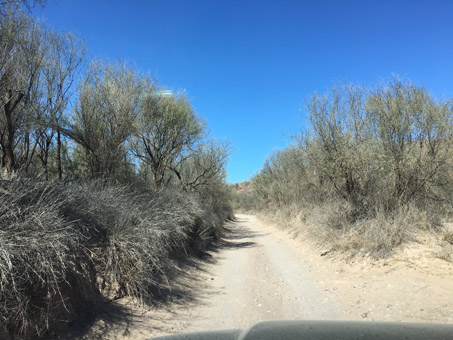
Road in the valley in May 2022.

Road in valley near that of previous photo in Nov 2022 with lots of vines (Brandegea bigelovii) covering the fences and Bufflegrass / Zacate Búfel (Cenchrus ciliare) lining the road.
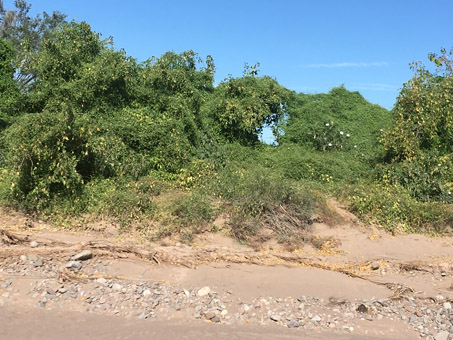
Desert Starvine and Cedros Balsam-apple / Enrededera Guisapol (Brandegea bigelovii and Echinopepon minimus var. peninsularis) densely covering trees, cactus and shrubs in the Mulegé valley.

Ah, living in a small, rural town, you sometimes have to contend with the morning commuters.

Desert Starvine (Brandegea bigelovii),
a fast-growing native perennial.
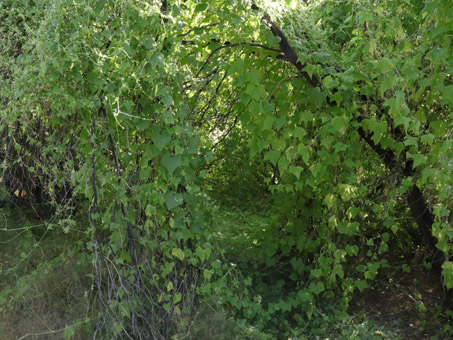
Desert Starvine climbing over shrubs and trees in the valley. There is a nice shady area behind the nearest vines large enough for a 4 person tent! There are signs of use by livestock in some of these shady bowers.
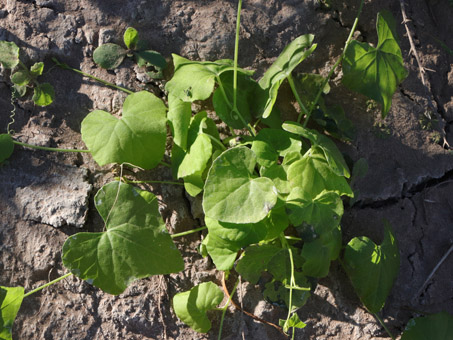
Young Desert Starvine plant.
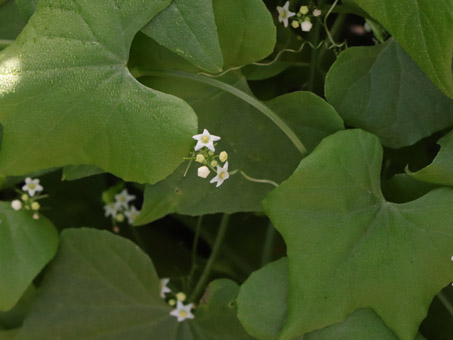
Desert Starvine flowers are 3-5 mm D with both staminate and pistillate flowers on a raceme. The flat, sparsely prickled fruit is also 5-6 mm L with a similarly sized beak. It is dry and indehiscent.
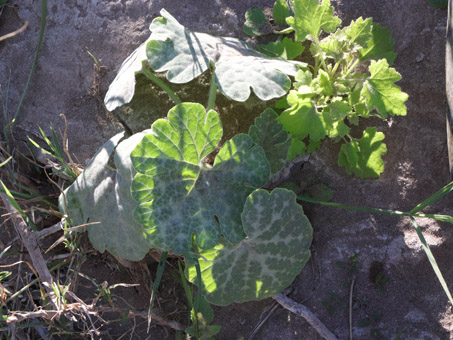
New leaves of the endemic perennial vine Baja California Melon / Calabacilla Amarga (Cucurbita cordata).
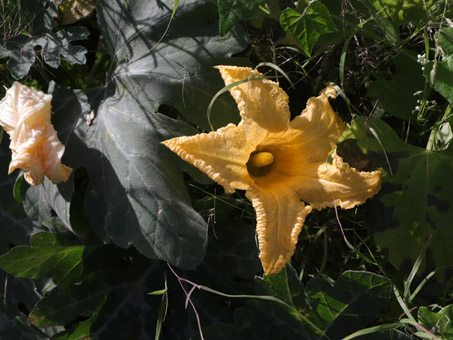
Staminate flower of Baja California Melon. It measures about 10 cm D. Pistillate and staminate flowers occur on the same plant.
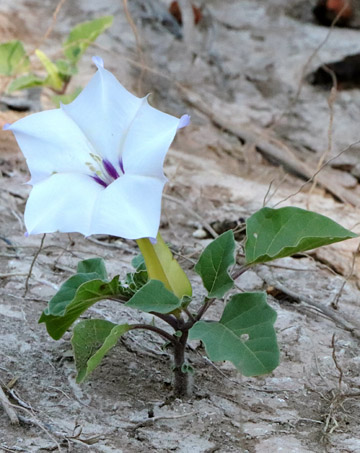
This Desert Thornapple / Toloache (Datura discolor) stood about 15-18 cm H with one beautiful, fragrant flower.
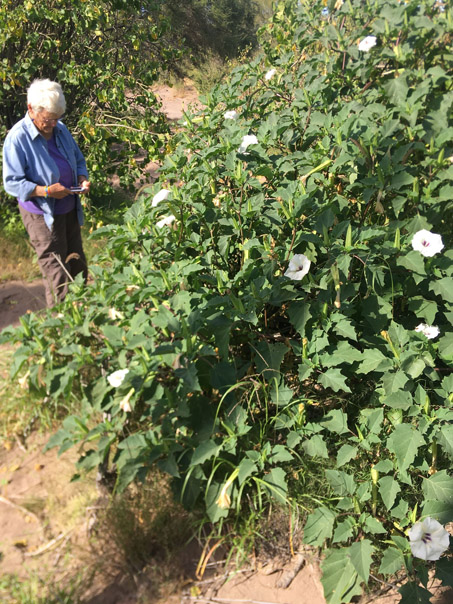
Not far away, in contrast, this Desert Thornapple was almost 2 meters tall!
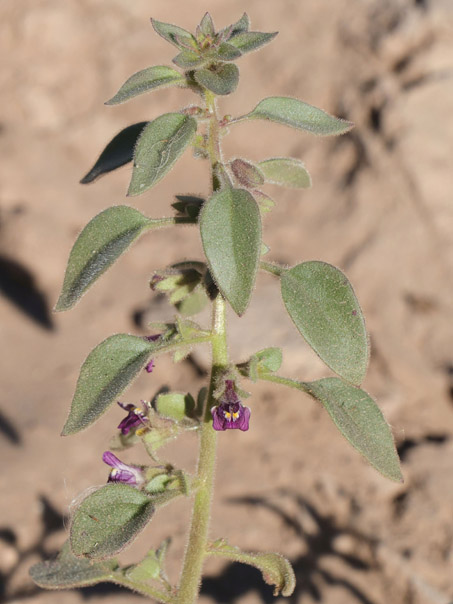
With so many plants on the peninsula and in California to choose from, I still think that this has to be my all-time fave: Canyon Snapdragon (Pseudorontium cyathiferum). It's just too cute!

The flowers of Canyon Snapdragon are just 8-9 mm L. Plants can range from 5 cm to 60 cm H. (Pseudorontium cyathiferum). The herbage and flower are glandular-pubescent.
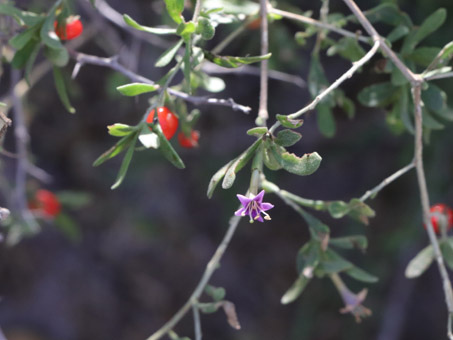
Hairy Desert Thorn / Frutilla (Lycium andersonii var. pubescens). This is a near endemic species, somewhat common in desert scrub along the Gulf coast mid-peninsula.

Hairy Desert Thorn. The fleshy, juicy berry is globose to ovoid, 8-12 mm L and often edible, though sometimes a little dry and bitter.
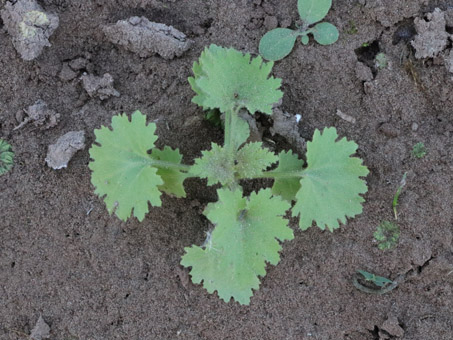
Seedling of Baja California Rock Daisy / Manzanilla (Amauria rotundifolia). This is a common endemic species found in desert scrub as well as in riparian areas where it does especially well.

The herbage of Baja California Rock Daisy is glandular pubescent with a strong, somewhat unpleasant odor. Flowers are about 20-25 mm D.
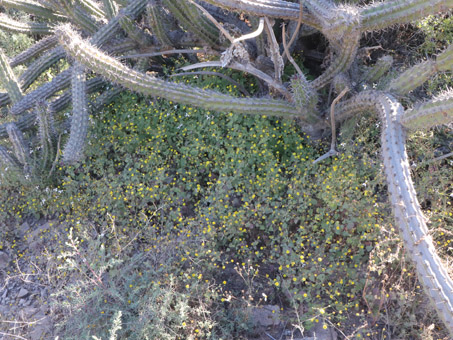
California Rock Daisy / Manzanilla del Monte (Perityle californica) is one of four common species in the area. The way it grows in dense patches around the base of shrubs and cacti is common after wet summers. Click on the image to see a closeup of the leaves.
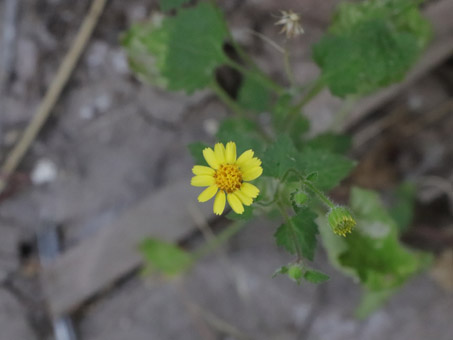
California Rock Daisy flowers are 10-12 mm D.
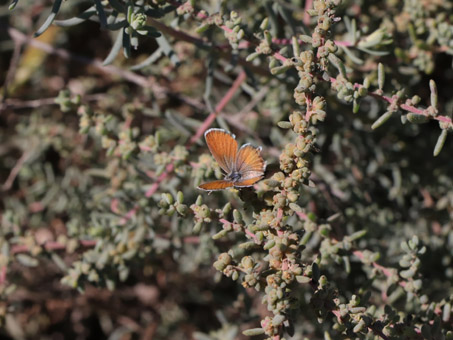
Western Pygmy-Blue / Mariposa azul pigmea (Brephidium exilis) These tiny butterflies, with a wingspan of only 12-20 mm, were everywhere when we arrived and throughout much of the winter.

I encountered Western Pygmy-Blues in a number of places on a variety of plants in various families.
According to Butterflies and Moths of North America, the Western Pygmy Blue is found “in alkaline areas such as deserts, salt marshes, and wasteland”. The larval host plants are primarily Saltbush / CHamizo (Atriplex spp.) as well as other plants in the Chenopodiaceae family, such as the Seablite / Quelite salado (Suaeda nigra) pictured above. I likely saw a number of males, as they were displaying behavior that the website describes as "patrolling over the plants looking for receptive females".
At one location where I had stopped to take photos of a plant, I happened to look down to watch my step and avoid the dense cover of Desert Horse-Purslane / Verdolaga de Cochi (Trianthema portulacastrum), a succulent in the iceplant family common in alkaline soils. I had a hard time focusing on the plant at first and finally realized that there were probably about 6-8 Pygmy Blues flitting back and forth over the plant so quickly that they were just blurs across the plant. It wasn’t until one finally came to a stop that I was able to see what it was and did eventually manage to get some photos. More Pygmy Blues (second photo) were feeding on the nearby flowers of a Tinta (Stegnospermum halimifolium).
That's it for this month, but I have lots more to share in the coming months. Until then, hasta luego...
Debra Valov—Curatorial Volunteer
References and Literature Cited
Lotts, Kelly and Thomas Naberhaus, coordinators. [2023]. Butterflies and Moths of North America. Brephidium exilis. Accessed 2022-12-23 at https://www.butterfliesandmoths.org/species/Brephidium-exilis
Rebman, J. P., J. Gibson, and K. Rich, 2016. Annotated checklist of the vascular plants of Baja California, Mexico. Proceedings of the San Diego Society of Natural History, No. 45, 15 November 2016. San Diego Natural History Museum, San Diego, CA. Full text available online.
Rebman, J. P and Roberts, N. C. (2012). Baja California Plant Field Guide. San Diego, CA: Sunbelt Publications. Descriptions and distribution.
Valov, D. (2020). An Annotated Checklist of the Vascular Plants of Mulegé, Baja California, Mexico. Madroño 67(3), 115-160, (23 December 2020). https://doi.org/10.3120/0024-9637-67.3.115
Wiggins, I. L. (1980). The Flora of Baja California. Stanford University Press. Keys and descriptions.

























































